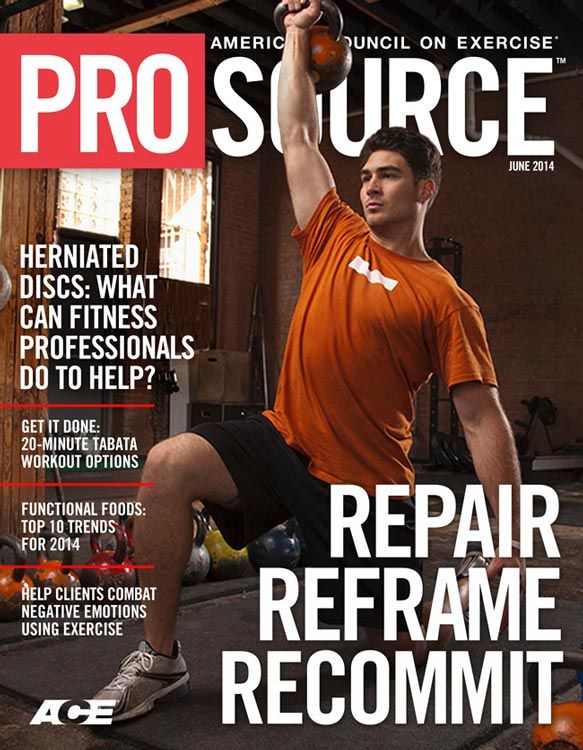Get it Done: 20-minute Tabata Workout Options
The idea of getting a full-body workout in just four short minutes has made Tabata-style training hugely popular. What originally began as a high-intensity, interval-training protocol performed on a cycling ergometer by Japanese Olympic speed skaters has now morphed into Tabata-inspired workouts that combine everything from plyometrics to traditional resistance-training exercises. Regardless of the types of equipment or exercises used, these workouts feature the same format of eight cycles of 20 seconds of high-intensity work followed by 10 seconds of rest.
ACE recently sponsored a study at the University of Wisconsin-LaCrosse that examined the true calorie burning potential of a 20-minute Tabata-inspired total-body workout. Participants burned, on average, 15 kcals burned per minute, confirming that full-body Tabata-style workouts can go a long way toward enhancing health and facilitating weight loss.
For more information on Tabata-style training, check out these resources.
High-intensity Interval Training
Everything You Need to Know About Tabata Training
This time-efficient approach to exercise is all about intensity, so while just four minutes of hard work can prove helpful in terms of enhancing health and fitness, the complete 20-minute, total-body workout experience can elicit even better results, while still easily fitting into a busy schedule. Here are three 20-minute Tabata-style workouts to use with clients that are able to perform high-intensity workouts, whether during training sessions or on their own. The 20-minute video option is particularly effective for those times when your clients can’t get to the gym or during their solo sessions. Just make sure they perform Tabata-style workouts no more than two to three times a week, allowing at least 48 to 72 hours rest between each session.
TABATA-STYLE WORKOUT #1
Use a stationary bike such as the Schwinn AirDyne spinning model, because its resistance increases as you pedal harder. Keep in mind that using a treadmill requires the client to jump on and off during each 20/10 cycle, which could increase the risk of injury.
Start with an eight-minute progressive warm-up, gradually increasing in intensity to an intermediate level of 70 percent to 80 percent of VO2max—the point at which the client breaks a sweat.
Begin the first of eight 20/10 Tabata cycles, with the 20-second, high-intensity intervals at 100 percent of VO2max. After 20 seconds, quickly adjust the tension level to its lowest setting (or instruct the client to do so) and lightly coast for 10 seconds, then immediately increase it again. This Tabata cycle totals four minutes. End with an eight-minute cool-down comprised of stretching and lower-intensity bodyweight exercises, such as planks and side planks, to reduce the client’s heart rate. (Total time: 20 minutes)
MODIFIED TABATA WORKOUT #2 (from Patrick Streit, owner of Force Fitness Performance in Cincinatti, Ohio)
This complete metabolic conditioning circuit–based, Tabata-style workout utilizes the client’s bodyweight, a kettlebell and a TRX suspension trainer for resistance.
After a five-minute warm-up of myofascial release on a foam roller and dynamic stretching, repeat the following circuits four times:
- 20 seconds of push-ups/10 seconds of recovery
- 20 seconds of TRX recline rows/10 seconds of recovery
- 20 seconds of burpees/10 seconds of recovery
- 20 seconds of kettlebell swings/10 seconds of recovery
To cool down, simply repeat the warm-up. (Total time: 26 minutes)
TABATA-INSPIRED WORKOUT #3 (ACE Tabata Study Protocol)
Begin with a five-minute warm-up followed by four rounds of Tabata (eight reps of 20 seconds of work, 10 seconds of rest) with one-minute of rest between each round, and a 10-minute cool down. During the 20-second phase of high-intensity exercise, perform as many repetitions as possible.
Round 1 (4 minutes)
- 2 sets of high knees
- 2 sets of plank punches
- 2 sets of jumping jacks
- 2 sets of side skaters
Round 2 (4 minutes)
- 2 sets of jump rope
- 2 sets of high/low boat
- 2 sets of line jumps
- 2 sets of push-ups
Round 3 (4 minutes)
- 2 sets of burpees
- 2 sets of Russian twists
- 2 sets of squats
- 2 sets of lunges
Round 4 (4 minutes)
- 2 sets of mountain climbers
- 2 sets of push-ups
- 2 sets of split squats
- 2 sets of box jumps
More Articles
- ProSource™: June 2014
Herniated Discs: What Can a Fitness Professional Do to Help?
Health and Fitness Expert
- ProSource™: June 2014
Non-physical Yoga Techniques for Fitness Professionals
Contributor






